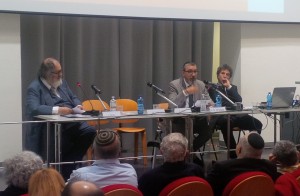CULTURE Remembering Shadal, a Great Italian Scholar
The life and work of the prominent Italian rabbi Shadal (Samuel David Luzzatto, 1800 – 1865) were celebrated in Padua last week.
Shadal was a Hebrew scholar and a poet, a historian and a biblical exegete, a translator and a bibliographer. His work as a teacher in the prestigious Rabbinical School of Padua, combining scientific research and Jewish tradition, made him one of the most renowned Masters of his time in Italy and worldwide.
Shadal’s rich and multifaceted character was explored in a conference held in Padua, on the occasion of the 150th anniversary of his death. The conference also marked the newest publication of his Commentary to the Torah after finding some manuscripts produced by several of his students, especially by the two brothers Ya’aqov and Itzhaq Pardo. The conference, organized by historian Gadi Luzzatto Voghera, was promoted by the Jewish Community of Padua and sponsored by the University of the city.
The manuscripts are the notes taken by the students during Shadal’s lessons in Padua, and were found and studied by Yonathan Bassi, who travelled the world to gather six of the precious documents and put the new edition together. The Commentary is a “gift that he has made to those of us who still use it,” according to Amos Luzzatto, former president of the Italian Union of Jewish Communities and direct descendant of Shadal. “He lived in a time and a space of cultural rebirth – Luzzatto said – and was a sort of forerunner of the scientific approach applied to the Scriptures, with the Torah as the object of his research and using as a method the one passed on by Jewish tradition.”
Samuel David Luzzatto was born in Trieste in 1800. He arrived in Padua 29 years later, called by rabbi Isacco Samuele Reggio to teach in the nascent Rabbinical College, where he stayed for the rest of his life, becoming an authority in the studies of Judaism. He had a rich correspondence with other personalities of Jewish culture of that time, some of which were later published. These are remembered in his dissertations in theology, history, philosophy and philology. Also, his role as an educator can be better understood by reading the manuals he wrote especially for his students, as requested by the rules of the Rabbinical School. They teach primarily about theology, ethics, history and linguistics. Among his publications there is also a very important Hebrew grammar. By spreading all this vast knowledge, as stressed by Bar Ilan professor Shemuel Vargon, his purposes were to “bring his students close to the Torah, give them the instruments in order to reply to those who were going against his principles, convey a great sense of morality and pass on Jewish values through the history of Am Israel.”
Among the many scholars and rabbis who spoke, there were also the chief rabbi of Padua Adolfo Locci, rabbi Gianfranco Di Segni, sofer Amedeo Spagnoletto, Felice Israel from the University of Genoa, Shaul Bassi from the University of Venice, and scholar Roberto Reuven Bonfil. Rabbi Giuseppe Momigliano, president of the Italian Rabbinical Assembly, and Davide Romanin Jacur, president of the Jewish Community of Padua, also brought their contributions to the conference.

